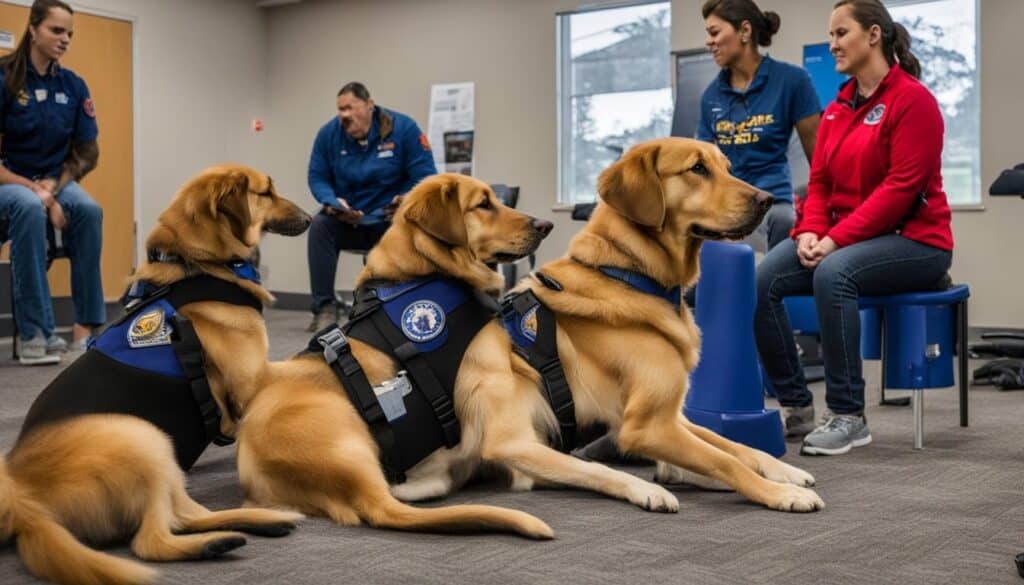How to Train a Seizure Alert Dog
Living with epilepsy can be challenging, especially when it comes to managing seizures and the potential risks they pose. But imagine having a loyal companion by your side, ready to provide assistance and support during those critical moments. That’s where a seizure alert dog comes in, trained to detect and respond to seizures, ensuring your safety and well-being.
In this article, we will explore the art of training a seizure alert dog, equipping you with the knowledge and techniques to train your furry friend to be your reliable protector. From understanding epilepsy and seizures to delving into the science behind a dog’s incredible detection abilities, we will cover it all. So, get ready to embark on this journey and learn how to empower your canine companion to become a lifesaving ally in your battle against seizures.
Understanding Epilepsy and Seizures
Epilepsy is a neurological disorder that affects the brain and can lead to seizures or abnormal behavior. Seizures occur due to abnormal electrical activity in the brain, causing a variety of symptoms and manifestations. The causes of seizures can vary and may include genetic factors, brain infections, head injuries, strokes, or tumors.
Seizures can present themselves in various forms, depending on the area of the brain affected. Some common types of seizures include focal seizures, generalized seizures, absence seizures, and tonic-clonic seizures.
Focal seizures occur when abnormal electrical activity is limited to a specific area of the brain. These seizures can cause a range of symptoms, such as sensory changes, involuntary movements, or confusion.
Generalized seizures involve abnormal electrical activity that affects both sides of the brain simultaneously. These seizures may cause loss of consciousness, convulsions, and muscle stiffness.
Absence seizures, also known as petit mal seizures, are brief episodes of unconsciousness that can last for a few seconds. They typically appear as staring spells or brief periods of unresponsiveness.
Tonic-clonic seizures, previously referred to as grand mal seizures, are the most well-known type of seizure. They involve loss of consciousness, convulsions, stiffening of muscles, and may be followed by confusion or exhaustion.
It’s important to note that epilepsy and seizures can have a significant impact on a person’s daily life and overall well-being. Understanding the causes and different types of seizures is essential in managing and treating epilepsy effectively.
The Role of Dogs in Seizure Detection
Dogs have an innate ability to detect when their owners are about to experience a seizure. This unique skill has led to the training of seizure response dogs, which can provide crucial assistance during and immediately after a seizure. These specially trained dogs can perform specific tasks that help individuals with seizures navigate through these challenging moments.
Seizure response dogs are trained by service dog organizations to recognize the signs and cues that indicate an impending seizure. They can sense changes in their owner’s behavior, body language, or scent, allowing them to intervene and provide support when it is most needed. These dogs play a vital role in assisting individuals with epilepsy, helping to ensure their safety and well-being.
Over time, some dogs develop the natural ability to detect seizures without formal training, becoming seizure alert dogs. These dogs can pick up on subtle changes in their owner’s physiology or behavior that signal an oncoming seizure. By alerting their owners, these dogs give them valuable time to take necessary precautions, such as finding a safe place or notifying a caregiver.
The Intuitive Bond Between Dogs and Their Owners
One of the reasons dogs are so effective in detecting seizures is the deep bond they form with their owners. Dogs are highly attuned to their owner’s emotions and physical cues, making them acutely sensitive to changes in their condition. This intuitive connection allows them to recognize even the slightest indicators of an impending seizure.
Seizure alert dogs are often trained to provide specific responses or tasks during a seizure. They can fetch medication, activate an emergency alarm, or provide comfort and support. By assisting their owners, these dogs offer a sense of security and independence that can significantly enhance the quality of life for individuals with epilepsy.
Beneficial Impact on the Lives of Individuals with Epilepsy
The impact of seizure alert dogs on the lives of individuals with epilepsy cannot be overstated. These dogs serve as loyal companions, offering emotional support during challenging times. They provide a constant presence and reassurance, which can alleviate feelings of anxiety and isolation that often accompany seizures.
Additionally, seizure alert dogs can help enhance safety by alerting family members, caregivers, or medical professionals when a seizure occurs. They can also assist with tasks such as retrieving medication or medical supplies, making it easier for individuals to manage their condition.
Furthermore, the companionship and bond shared with a seizure alert dog can help promote mental well-being and improve overall quality of life. Having a loyal and dependable companion by their side can give individuals the confidence to engage in social activities and pursue their personal goals.
As research continues to uncover the remarkable abilities of dogs in detecting seizures, the training and utilization of seizure alert dogs are expected to become more widespread. These remarkable animals offer a lifeline to individuals with epilepsy, providing invaluable assistance, comfort, and companionship.
The Science Behind Seizure Detection in Dogs
Scientific studies on seizure detection in dogs have revealed fascinating insights into their remarkable abilities. Dogs have shown an exceptional aptitude for canine scent detection, particularly when it comes to detecting specific scents associated with epileptic seizures.
Researchers have conducted experiments where dogs were trained to identify seizure samples among samples collected from epileptic patients. These studies have consistently shown that dogs exhibit a high level of accuracy in recognizing the unique scent released by individuals before a seizure occurs.
One study published in Journal of Neurology reported that seizure alert dogs successfully detected seizure-associated scents with an impressive 93% accuracy rate. This research provides strong evidence supporting the notion that dogs can detect the smell associated with seizures before they happen.
Additional studies have confirmed these findings, further highlighting the remarkable abilities of dogs in seizure detection. The accuracy and reliability of such detection emphasize the potential of utilizing dogs as valuable tools in assisting individuals with epilepsy.
While the exact mechanisms underlying this canine scent detection remain unknown, scientists speculate that dogs can pick up on subtle changes in chemicals, hormones, or even electrical processes that occur within the human body prior to a seizure. These findings have significant implications for further research and the potential development of innovative seizure alert technologies.
Research on canine scent detection and seizure detection in dogs is still ongoing, aiming to unravel the mysteries behind the remarkable abilities of these furry friends. These studies not only contribute to our understanding of epilepsy but also pave the way for the development of more effective seizure alert systems and training programs for dogs.
The Training Process for Seizure Alert Dogs
Training a seizure alert dog is a multi-step process that involves conditioning the dog to recognize the specific scent associated with seizures and teaching them alert behaviors. Here’s a breakdown of the training process:
- Pairing the scent: The first step is to pair the scent associated with seizures with positive reinforcement, such as food rewards. This helps the dog form a positive association with the scent and motivates them to learn.
- Repetition and conditioning: Through consistent repetition, the dog learns to recognize the scent and understand that it has significance. This conditioning helps the dog differentiate the seizure scent from other scents.
- Alert behaviors: Once the dog has been conditioned to recognize the seizure scent, the next step is to teach them specific alert behaviors. One common alert behavior is poking the owner with their nose multiple times. This behavior serves as a clear signal to indicate an oncoming seizure.
- Positive reinforcement: Training is done using positive reinforcement techniques, which involve rewarding the dog for displaying alert behaviors. This reinforces the desired behaviors and encourages the dog to respond without hesitation when they detect the seizure scent.
By following this training process, you can effectively train a seizure alert dog to recognize the scent associated with seizures and respond with appropriate alert behaviors. The training process requires patience, consistency, and positive reinforcement to ensure the dog’s understanding and reliability.

Tasks Performed by Seizure Alert Dogs
Seizure alert dogs play a crucial role in providing assistance during and after a seizure. These highly trained dogs are capable of performing various tasks to ensure the safety and well-being of their owners.
When a seizure occurs, seizure alert dogs may start barking to alert family members or caregivers. This loud and persistent barking serves as a signal for immediate attention, ensuring that help arrives promptly.
During a seizure, seizure alert dogs have been trained to lie next to the person, providing comfort and protection. This close proximity can help reduce anxiety and fears, offering a sense of security to the individual.
To prevent injury from falls, seizure alert dogs are trained to stand next to the person during a seizure. By providing physical support, these dogs act as a stabilizing presence, minimizing the risk of harm.
In critical situations, seizure alert dogs are taught to press alarm buttons or call devices for help. This action ensures that emergency services are notified promptly, allowing for immediate medical assistance during seizures.
Seizure alert dogs also provide invaluable mobility assistance to their owners. They can help guide individuals safely to a designated area during or after a seizure, preventing accidental injury.
Additionally, these highly trained dogs are skilled in retrieving dropped items for their owners. This task can be particularly helpful in situations where the individual may experience disorientation or confusion post-seizure.
Overall, seizure alert dogs perform a wide range of tasks that contribute to the safety and well-being of their owners during seizures. Their presence and assistance provide individuals with epilepsy with a greater sense of independence and improved quality of life.
Training Programs and Organizations
There are organizations and training programs specifically dedicated to training seizure alert dogs. These organizations often donate trained dogs to individuals in need. Additionally, some individuals train their own dogs with the help of professional trainers or on their own.
When seeking out training programs and organizations, it is crucial to work with reputable ones that prioritize the well-being and effectiveness of seizure alert dogs. Look for programs that have a proven track record of success and employ positive reinforcement training methods.
Reputable organizations may also offer support and resources throughout the training process, ensuring that both the dog and the individual with epilepsy receive the necessary guidance and assistance. These training programs and organizations play a significant role in ensuring the highest standard of training and the successful integration of seizure alert dogs into their new homes.
To find a training program or organization near you, consider reaching out to established organizations such as Canine Assistants or Pawsible Angels. These organizations have extensive experience in training dogs for various medical needs, including seizure alert. They can provide valuable information, guidance, and resources to individuals seeking seizure dog training programs.

Can Any Dog Be Trained as a Seizure Alert Dog?
When it comes to training a seizure alert dog, not all dogs are suitable for the task. The natural abilities and temperament of a dog play a crucial role in their potential as seizure alert dogs. The right temperament, characterized by calmness, gentleness, and obedience, is essential for a successful seizure alert dog.
The size of the dog is also a factor to consider. Certain tasks, such as retrieving items and pulling wheelchairs, require a dog of sufficient size and strength. While any breed has the potential to be trained, not all dogs possess the necessary qualities for seizure alert dog training.
Seizure alert dogs must be able to respond appropriately and effectively in various situations. Their training involves conditioning them to recognize the specific scent associated with seizures and to exhibit alert behaviors. This training requires patience, consistency, and specialized techniques to ensure the dog responds without hesitation.
If you’re considering training a seizure alert dog, it’s essential to assess your dog’s natural abilities and temperament before embarking on the training process. Working with professional trainers or organizations experienced in seizure alert dog training can help determine if your dog is suitable for this role and provide guidance throughout the training journey.
Personal Pets and Seizure Alert Abilities
While trained seizure alert dogs play a vital role in assisting individuals with epilepsy, there is also anecdotal evidence suggesting that personal pets may naturally develop the ability to respond or alert to seizures. Although scientific studies on the accuracy of pet dogs in detecting and predicting seizures are limited, many individuals have experienced their pets showing alert behaviors before or after a seizure occurs.
Pets often form strong bonds with their owners and have a deep understanding of their behavior and patterns. They might pick up on subtle changes, such as unusual movements, vocalizations, or changes in scent that occur before a seizure. These intuitive pets may exhibit behaviors like whining, pacing, pawing, or showing increased attention towards their owner, indicating that they are aware of an impending seizure.
It’s important to note that while anecdotal evidence suggests the ability of personal pets to detect seizures, their accuracy and consistency may vary. Unlike trained seizure alert dogs, personal pets may not possess the same level of training to perform specific tasks during a seizure. Nevertheless, they can still provide valuable emotional support and companionship to individuals with seizures.
Interacting with a pet dog can have a calming effect on individuals with epilepsy, reducing stress and anxiety. The unconditional love and non-judgmental presence of a pet can help alleviate feelings of loneliness and isolation that can often accompany the condition. Pet dogs can offer comfort and a sense of security, establishing a strong bond with their owners that can be particularly beneficial during and after seizures.
Showcased in Figure 9, the image below captures a heartwarming moment between a pet dog and its owner during a seizure. The image depicts the unique connection that personal pets can share with individuals with epilepsy, offering them emotional support and reassurance.
While personal pets may not possess formal training as seizure alert dogs, their presence and ability to provide emotional support can make a positive difference in the lives of individuals with epilepsy. It is essential, however, to consult with healthcare professionals, including veterinarians and neurologists, to ensure comprehensive management of epilepsy and explore all available options for seizure detection and assistance.
The Benefits of Seizure Alert Dogs
Seizure alert dogs play a vital role in improving the quality of life for individuals with epilepsy. These specially trained dogs provide a range of benefits that contribute to increased safety and overall well-being.
One of the key advantages of having a seizure alert dog is the sense of security they provide. With their trained ability to detect seizures before they occur, these dogs can help individuals feel safer and more confident in managing their condition. The presence of a seizure alert dog can alleviate anxiety, knowing that assistance is readily available when needed.
During seizures, seizure alert dogs can be trained to perform specific tasks that can be challenging for individuals. They can offer physical support by standing or lying next to the person, reducing the risk of injury from falls. Additionally, these dogs can help with tasks such as pressing alarm buttons or retrieving medication, providing critical assistance during and after a seizure.
Seizure alert dogs also contribute to an improved quality of life by promoting independence and enabling individuals to engage in daily activities more confidently. With their loyal companionship and assistance, individuals with epilepsy can pursue their goals, participate in social interactions, and achieve a greater level of autonomy.
In conclusion, seizure alert dogs offer numerous benefits, including increased safety, improved independence, and enhanced overall quality of life. These remarkable dogs provide not only practical assistance but also emotional support and companionship for individuals with epilepsy.
Obtaining a Seizure Alert Dog
If you or someone you know is in need of a seizure alert dog, the process of acquiring one may vary depending on individual goals and needs. Working with professional trainers and reputable organizations can help guide you through the process and determine the best approach for obtaining a seizure alert dog.
When seeking a seizure alert dog, it’s important to research and carefully consider any claims made by trainers regarding a dog’s ability to detect and alert to seizures. Look for trainers who have experience specifically in training seizure alert dogs and can provide references or testimonials from previous clients.
Reputable organizations that specialize in training seizure alert dogs can also be invaluable resources. These organizations often have established training programs and work with certified trainers who have expertise in this area. They may have a waiting list or application process in place, so it’s important to reach out and inquire about their specific requirements.
During the process of obtaining a seizure alert dog, be prepared for evaluations and assessments to determine the suitability of both the individual and the dog for this specialized training. These evaluations may include assessing the individual’s needs, lifestyle, and ability to care for a seizure alert dog, as well as evaluating the dog’s temperament, health, and ability to perform the necessary tasks.
It’s essential to remember that further research is still needed to better understand the unique skill of seizure detection in dogs and how it can be developed. As such, it is crucial to approach the process with realistic expectations and seek guidance from professionals with expertise in training seizure alert dogs.
Acquiring a seizure alert dog can be a life-changing experience for individuals with epilepsy. With the guidance and support of experienced trainers and organizations, you can navigate the process and potentially find a seizure alert dog that will become a valued companion and provide assistance during and after seizures.
Conclusion
In conclusion, training a seizure alert dog involves specific steps and techniques to condition the dog to recognize the scent associated with seizures and respond appropriately. By collaborating with experienced trainers and organizations, individuals with epilepsy can ensure the successful training and integration of a seizure alert dog into their lives.
Seizure alert dogs play a crucial role in providing invaluable assistance and improving the safety and quality of life for individuals with epilepsy. They can help during and after a seizure, performing tasks such as alerting family members or caregivers, providing comfort and protection, preventing injuries from falls, and even retrieving dropped items. Their presence and support bring a sense of security, allowing individuals to engage in daily activities with increased confidence.
When acquiring a seizure alert dog, it is important to work with reputable trainers and organizations that prioritize the well-being and effectiveness of these specially trained dogs. While any breed has the potential to be trained, not all dogs possess the natural abilities and temperament required. Therefore, careful consideration must be given to the suitability and compatibility between the individual and the dog.
Overall, training a seizure alert dog is a comprehensive process that involves dedication, patience, and collaboration. The remarkable abilities of seizure alert dogs have the potential to make a significant difference in the lives of individuals with epilepsy, providing them with greater independence, safety, and emotional support.






